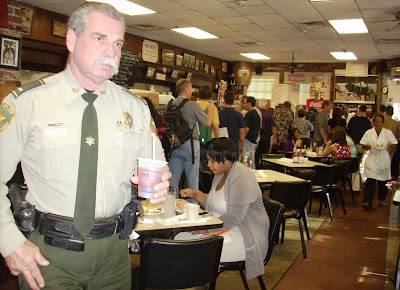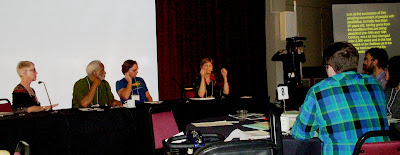As the
only SFSU gerontology student at last year’s Gerontological Society of America
(GSA) annual meeting ,
I became (by default) GSA Campus Ambassador,
which involved promoting GSA membership and activities, re-activating our gerontology
honor society (Beta Xi chapter of Sigma Phi Omega), obtaining Careers in Aging
Week (CIAW) award, etc. Eager to retire from
Ambassador duties, I was pleased when seven classmates joined me at last
month’s GSA annual meeting in New Orleans (birthplace of Benjamin Button,
who looked like an old man at birth, so he was abandoned on the porch of a
nursing home and then he kept growing younger)!
President’s
Welcome Reception & Exhibit Hall Opening – enjoyed Mardi Gras and
muffuletta
What a
difference a year makes (getting wiser with age and experience): last year, I
was ambivalent about starting over again with a new career and now I feel more
confident about this change. Instead of being all over the place like last
year, I am now more focused on health promotion, home- and community-based
services to support aging in place, and elder rights protection.
Optimal v.
Successful Aging
Adapting
to change has a lot to do with Optimal Aging, the theme of this year’s GSA
annual meeting. According to The Optimal Aging Manual author Dr. Kevin O’Neil,
the definition of optimal aging is necessarily subjective as it takes
into account psychosocial factors
like resiliency, adaptability, good self-esteem, positive attitude,
self-efficacy, as well as spirituality.
Unlike
Rowe & Kahn’s 1997 definition of successful aging (based on avoidance
of disease and disability, the maintenance of high physical and cognitive
function, and sustained engagement), optimal aging recognizes that people can age well in spite of disabilities or chronic
conditions. As Dr. Kenneth
Brummel-Smith wrote in his 2007 Annals of Long Term Care articles on Optimal Aging, “almost all older people are interested in a life that is
meaningful, fulfilling, and relatively independent,” and “much of optimal aging is under the individual’s control;
however, ideally, society provides support and assistance in helping its
members achieve optimal aging."
In The Gerontologist’s December 2013 article,
“Perceptions of Successful Aging Among Diverse Elders With Late-Life Disability," a diverse group of On Lok seniors in San Francisco perceived Successful Aging
as accepting limitations in ADLs/IADLs;
adapting to optimize functions that
are important to them (e.g., “if I cannot walk, I’ll use a walker. If I can’t use the walker, . . . I will use
the wheelchair”); trusting in God;
and shifting priorities (focus on
positive)—rather than rejecting their new reality by clinging to the notion of
successful aging as being forever young or middle-age, which is arguably
ageist.
Ageism
Ageism
“Standing in the way
of optimal aging, however, is that familiar foe: ageism.”
-- U.S. Department
of Health & Human Services blog post, Ageism: How Negative Stereotypes of Aging Impede an Inclusive Society
The term
ageism (discrimination based on age) was coined in 1968 by Robert Butler
Chronological Age Doesn’t Tell the
Whole Story: Current Directions in Perceptions of Aging Research (BSS) looked at older adults’ subjective
perceptions of aging and consequences for their functioning. In Subjective Aging and Cognitive Functioning: A 10-Year Prospective Study, Yannick
Stephan (photo above) found that more stressors and poor health make people feel “older,”
which is a risk factor for cognitive deficits.
“Younger” subjective aging is associated with lower mortality risk,
better life satisfaction, better self-rated health, and better physical
functioning. In When Feeling Different Pays Off:
How Older Adults can Counteract Negative Age Stereotypes, David Weiss discussed older adults’ self-protective responses of distancing,
differentiation, and shifting to alternative age identities (e.g.,
generation).
Social
Psychological Perspectives on the Implications of Ageism for Health and Health
Care Professions (BSS) symposium by Age UK researchers included Hannah Swift’s Being Old and Ill Across Different
Countries: Social Status, Age Identification and Older People's Subjective
Health: in European countries where older people are perceived as having lower social status, strongly identifying with
the old age group is related to higher levels of subjective ill health; in
countries where the status of older people is perceived as higher, there was no
relationship between age identification and self-rated health. (UK law includes age as "protected characteristic" in its Equality Act of 2010, though this ban on age discrimination in the provision of goods and services does not extend to financial services.)
In An
Applied Test of the Contact Hypothesis: Exploring the Effects of Contact with
the Elderly on Care Workers’ Attitudes, Libby Cuthbert found that while
positive contact between age groups reduces prejudice (i.e., less explicit ageism,
less dehumanization, and more empathy), outcomes of negative contact (more
dehumanization) were more enduring than positive.
Meeting Together
GSA Executive Director James Appleby welcomed
3,300 meeting registrants
Keynote speaker Bruce Clark, a
marketing specialist focused on baby boomers and mature consumers, set the agenda
for GSA attendees of the world’s need for our “expert voices” to counter “sound-bite”
mentality. In this blog post, I’ll attempt
to provide bite-size expert voices.
2012 Kleemeier Award recipient Eileen Crimmins of USC presented lecture, Lifespan and Healthspan: Past, Present and Promise. She concluded that increasing lifespan and healthspan should not
depend only on scientific discoveries, but opportunities to substantially
increase life expectancy with behavioral changes, improvements in early life
circumstances, and reductions in health disparities.
Chronic Disease
Self-Management Program (CDSMP)
Dr.
Brummel-Smith identified the evidence-based CDSMP as a societal approach to
optimal aging.
Living Well with Chronic Illness: Comparing
Research and Policy Developments in Australia ,
Canada , U.S. and China Australia
National Dissemination of Evidence-Based
Health Promotion for Older Adults: Successes, Challenges and Impact (SRPP) symposium
with Marcia Ory (Texas A&M), Janet Frank (UCLA), Kristie Kulinski (NCOA), and Michele Boutaugh (ACL). Discussant Michele
Boutaugh mentioned that grant funding is not a strategy for expansion, but we
need to build delivery into healthcare (both referrals and funding) for
sustainability.
Last
year’s GSA President Nancy Whitelaw of the National Council on Aging (NCOA) collaborated with CDSMP developer Kate Lorig and Texas A&M researchers
Marcia Ory and Matthew Lee Smith, in the national evaluation of CDSMP in the U.S.
Unbeknownst
to me while at GSA meeting, California Association of Area Agencies on Aging
(C4A)—which held its annual meeting at the same time in Los Angeles—presented
San Francisco Department of Aging and Adult Services an award to San Francisco Healthier Living Coalition for sustainability! Woo-hoo!
Self-Management of Disability and
Optimal Aging: Current Trends in Research, Policy & Practice (SRPP)
symposium included Outcomes of CDSMP for Persons with
Disabilities presentation by Phillip McCallion,
who found CDSMP participation improved outcomes for persons with disabilities
that significantly impair daily functioning.
His next study will examine persons with intellectual/developmental disabilities
participating in CDSMP adaptation, as there exist versions of CDSMP tailored to
particular groups.
Aging in place
Aging in Multiple Environmental Settings: What Factors Contribute to Optimal Aging? (BSS)
The Village Model: A Unique Organizational
Approach to Fostering Aging in Place? (SRPP) The Gerontologist’s December 2013 issue published “A Tale of Two Community Initiatives for Promoting Aging in Place: Similarities and Differences in the National Implementation of NORC Programs and Villages" article authored by panelists Emily
Greenfield, Andrew Scharlach, Amanda Lehning, and Carrie Graham. This research team also created a companion
website, Aging and Community: A National Study of NORC Programs and Villages.
Theoretical and Empirical
Developments in Understanding Aging in Place & Relocation (SRPP) covered continuum of care from homeless to housing to assisted living to
skilled nursing facility. People make
choices based on a cost-benefit analysis of where they are to alternatives that
consider value of stability/status quo; the most vulnerable are those “stuck in
place.”
Inspiration
At last
year’s GSA meeting, I really didn’t know anyone other than SFSU professors but
found it easy to connect with other attendees.
This year’s meeting was like a reunion as I got re-acquainted with my
favorite gerontologists!
SSAI Executive Director Tony Sarmiento with Keith Whitfield, co-author of Handbook on Minority Aging. Tony also hosted Concept Coffee, with continental breakfast (beignets), to discuss career path options.
SFSU representation
SFSU Gerontology
Professor Darlene Yee (missing from this year’s GSA meeting because she was
attending CANHR’s 30th anniversary celebration)
will co-chair GSA annual meeting in 2015, which marks the 50th
anniversary of the Older Americans Act!
Exhibit hall &
poster session
At
poster session, National Association for Professional Gerontologists (NAPG) Executive Director Donna Schafer stood in for SFSU Gerontology Professor Anabel Pelham to discuss Assessing Gerontology
Competencies: A Pilot Study – which involved graduate gerontology students (including yours truly) responding
to essay questions in this research to measure competencies, as part of a
larger plan to credential gerontologists.
Dear Aunt
Polly and Uncle Pete are therapeutic older couple dolls created by a psychiatrist.Judy Berry founded Lakeview Ranch, which provides specialized dementia care in rural
GSA & NIH (National Institutes of Health) booths offered useful research publications.
Geroscience:
Societal Implications of Delaying Aging
This
meeting was a follow-up to last month’s Trans-NIH Geroscience summit that explored the physiological effects of aging as
a common risk factor for chronic diseases affecting the aging population. Do aging biology (nature) or lifestyle (nurture)
factors cause chronic disease? Cancer,
diabetes and obesity are found in younger populations, so it’s not like aging
is a disease to attack. The Fall 2013
issue of Public Policy & Aging Report (now included as GSA member benefit!)
is devoted to The Longevity Dividend: Geroscience Meets Geropolitics.
Aubrey de Grey delivered his expert opinion:
“I think we have a 50% chance of adding 30 years to seniors’ healthy
lifespans within 25 years by damage repair, subject to funding.”
Laissez Les Bon
Temps Roulez (Let the Good Times Roll)
The GSA meeting venue was split between
Marriott (near French Quarter) and Sheraton (Central Business District) on
opposite sides of Canal Street San
Diego
Sampled Creole sauces in French
Quarter store
Took a break from information overload during poster session to visit nearby
Rain on parade
As a
thrifty graduate student, I took a red-eye flight out of SFO with stopover in ORD
(Chicago) before arriving in MSY (New
Orleans
Po-Boy ending
After
last session ended on Sunday, I took the trolley over to Oak Street Po-Boy Festival!
Live music outdoors in sunny afternoon































































